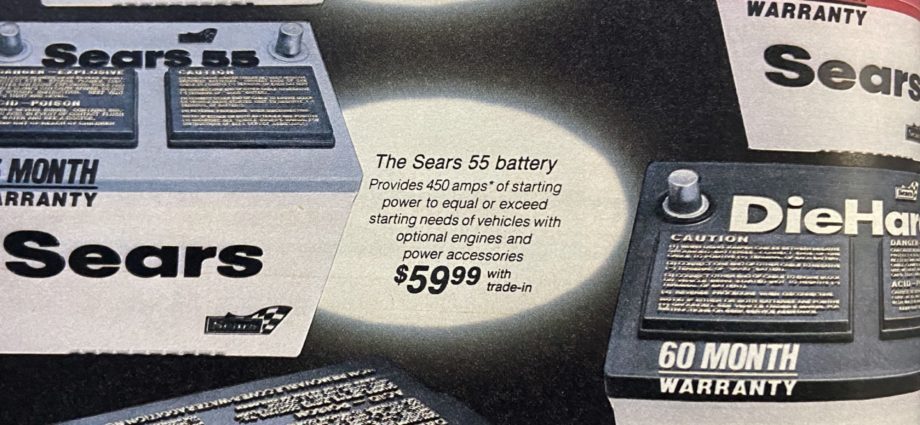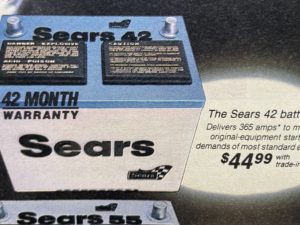SAN ANTONIO – Sears has opened a new spin-off concept, the Die Hard Auto Center. Of course, Die Hard is a strong Sears brand, and this news is just coming off Sears’ sale of Craftsman for an astounding $775 million to Black & Decker.
Currently, Sears Holdings is on track to do a Pan Am. That is, a great, iconic (an easily overused word, but true here) brand name company is now in the business of selling off the family silver. Pan Am did it by selling its headquarters, the Pan Am building, Inter-Continental Hotels, Falcon Jet, its Asian routes, the Pan-Am Shuttle and other subsidiaries. It was then left with its money losing airline, which went bankrupt. The brand then went up for auction and Pan Am, just the globe icon, sold for about $200K.
Sears has done a slightly different route, however, and in some ways quite interesting. The thesis: a company should create and spin off many companies as it grows powerful. That way, the economic value of the company survives if the main business struggles.
However, there is a corollary idea, namely that you want to exit the unprofitable businesses and keep the profitable businesses as part of the main company. Thus, if Pan Am had kept its hotels, regulated foreign routes, shuttle, office building, jet company and training subsidiary, it would still be around. Hindsight is easy of course; perhaps Sears should have kept Discover, Allstate and other assets, and sold off the stores. General Electric is the best example of this; while I find it painful that GE no longer makes light bulbs or toasters, it licenses the GE brand for Christmas lights and such, and rolls on in more profitable areas.
Craftsman went for a reported $525 million and then $250 million at the end of the third year, with receipts to go into Sears Holdings proper. The Sears Tower went in 1994. Other assets have been spun off separately, with a Sears identity. For instance in 2012, they spun off Sears Hometown and Outlet (Nasdaq: SHOS), which still has a low stock price (less than $4 at this time), but is conceivably going to survive whatever happens to Sears Holdings proper. Lands End, which was a prize company, was spun off as well into a separate entity with shares now at about $18 (Nasdaq: LE). It also purchased, developed and spun off the Orchard Supply retailer, among many other side ventures. Other spin offs of Sears include stores in Canada and Mexico; we assume the brand will survive in those countries if managed effectively.
That being said, Sears Holdings stock has gone from an astounding $190 a share to now $7.39 as I write. That is not a good record. And its route down has been odd; the merger with Kmart has meant an odd, odd combination of a notable brand retailer known for quality, married to a bankrupt chain known for being cheesy, tacky and inferior. That being said, what Sears has done with some of the stores is quite remarkable considering how much a mess Kmart was. And it was an awful mess; as much as I like old brands, Kmart is a true challenge.
Oddly, in its time of trial Sears has been working on preserving its place in home delivery retail, a field that it invented, with millions invested in the Shop Your Way program. While it has been innovative in some ways, I never felt like it all added up as whenever I shopped at a Sears, Land’s End or Kmart, I just ended up with a bunch of coupons stuck to my receipt. Perhaps Shop Your Way is a way to make up for the appalling loss of the shut down of the Sears Catalog, which should have been preserved in some form, and not eliminated entirely.
The DieHard auto store is perhaps a smart move; the prototype is handsome and well thought out. Anything that can slightly separate the sometimes profitable Sears Auto stores (often located in a separate building in mall parking lots) from ailing malls and main Sears stores is a smart move. Using the DieHard brand for it allows the stores to claim the Sears identity (powered by Sears) and yet not be taken down from it if the mother ship is ailing. In 2014, it was expected that the auto stores had about $1 billion in value that needed to be defined and unleashed.
The recent sale of Sears’ prize assets is not new. Whether or not Sears survives as a full-scale retailer, it has a powerful network of brands that are successful spinoffs of the company. And whatever happens with Sears Holdings, the legacy will live on. Allstate, the insurer, was born as a store brand of Sears selling automobiles and tires. It later branched into car insurance in the 1930s. Discover Card was also an innovation of Sears; it was an outrageous notion that a tired old retailer could launch its own charge card to compete with Visa, MasterCard and American Express. But it was successful.
Companies should think about longevity, sustainability and eternity when they plan for the future. Thinking about what happens if your main business tanks is a good idea to do before the market shifts.
Fixing Sears is a challenge. I wrote years ago that they ought to investigate reviving many of their classic brands, as part of their store portfolio, including Ted Williams and Coldspot. Sears also had other unused, but terribly elegant, brands like Sears Yachtsman, which was ignored during the time of Lands End but still have potential. The trouble, however, is that when the main mother ship is ailing, it is hard to power up new brands, even with a Die-Hard battery.










Two thoughts:
First, Sears Auto Centers are always busy so a spin-off utilizing the “Diehard” brand ought to be a success. They already have branded products being produced that have a good reputation and a understanding how auto service centers need to be run; this might be a great franchising opportunity in addition to corporate stores.
Second, Stanley Black & Decker owns Mac Tools and Dewalt so while S B & D branded tools do not have the reputation that Craftsman has, they do know how run divisions that have better reputations (especially Mac which is a very close second to Snap-On in regards to quality).
I own all of the mentioned brands, have found that the Craftsman Professional line to be very good and am looking forward to an expansion of the line (and their industrial line) now that S B&D owns it.
thanks scott…glad to know the relative strengths of the brands…